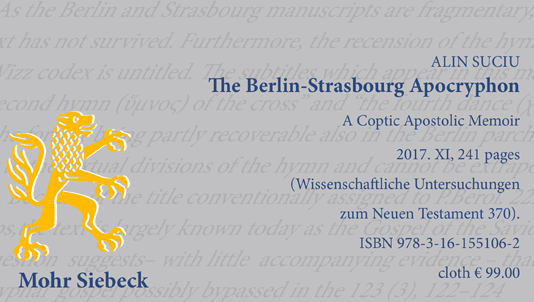In 1995, Charles Hedrick announced at the SBL/AAR meeting the discovery of a Coptic parchment manuscript that supposedly preserved an ancient Christian Gospel. It was later dubbed the Gospel of the Savior and was supposed to have been composed in the latter half of the second century, bypassed for inclusion in the canon. The scholarly consensus up to now has been in favor of such an early dating. The supposed discovery of yet another early writing rejected as orthodox by the Fathers grabbed much attention.
Alin Suciu, however, argues in his The Berlin-Strasbourg Apocryphon that this writing has been misunderstood. Now known as the Berlin-Strasbourg Apocryphon, this writing–argues Suciu–belongs to an ancient Coptic literary genre of “apostolic memoirs” and should not be dated before 450 C.E.
The Manuscripts
The BSApo is comprised of three related sources (pp. 26–69). The first is P. Berol. 22220, whose origin is unknown. It is the longest manuscript of the three, but it is missing many lines and its exact length is unknown due to manuscript damage. The second source includes papyrus fragments Strasbourg Copte 5–7, which are housed in the Bibliothe`que Nationale et Universitaire in Strasbourg. Their provenance is also unknown. The Qasr el-Wizz Codex is the third and is housed in the Nubian Museum in Aswan. It probably dates to around 1000 CE, and may be a secondary witness to the BSApo, since the contents it shares with the other two sources are abbreviated.
The Contents
The BSApo contains at least four topics shared across the three sources. The fact that all three are part of the same text is a more recent decision by Coptologists. The four topics are two different revelations of Christ, a hymn of the cross, and an excerpt of Ps.-Chrysostom’s In venerabilem. The Hymn of the Cross is shared by P. Berol. 22220 and Qasr el-Wizz, but is abbreviated in the latter; the second revelation of Christ is shared by the Strasbourg Copte 5–7 and Qasr el-Wizz; P. Berol. 22220 alone has the first revelation of Christ.
When pieced together, this apocryphon is a pastiche of the Gospel narratives and focuses on the final days of Christ. He reveals many things to his apostles, mostly sayings that are adapted from the canonical Gospels. The hymn to the cross also extols the glory of what Christ accomplished there.
Re-situating the BSApo
Suciu’s contribution is, first, to provide “semi-diplomatic editions of the three manuscripts [in Coptic], accompanied by translations into English” (p. 139).
Secondly, Suciu provides a lengthy introduction that tries to situate the BSApo historically. Rather than being an overlooked second-century Gospel, Suciu situates the BSApo among an ancient Coptic literary genre of apostolic memoirs (pp. 70–107). These memoirs were often embedded in sermons attributed to church Fathers (usually pseudonymous) and claimed by be written by the apostles. The genre contains at least two dozen texts.
Coptic apostolic memoirs often claim to have been discovered in a library in Jerusalem, where they were deposited by the apostles or their followers. They discuss topics such as angels, the birth, passion, and resurrection of Christ, and holy figures and places. These events often align with dates in the Egyptian liturgical calendar, suggesting that the writings were attempts to legitimize Coptic Christian traditions. These texts also often use similar phrases, such as “O my holy members,” which appears in the BSApo (108–120).
Finally, Suciu demonstrates miaphysite Christology throughout many of these memoirs, including spots in the BSApo, and argues that such evidence must place the sources after the council of Chalcedon, where the dyophysite view (Christ’s divine and human nature are distinct) won the day (pp. 128–138). By attributing to the apostles memoirs that espouse miaphysite Christology, Coptic Christians may have been trying to legitimate their distinctive (non-orthodox) position.
Evaluating Suciu’s Argument
I do find this dating argument to be the one weak spot in the book, since non-orthodox positions created the need for councils, which means these memoirs could just as easily have been pre-Chalcedon and part of the reason for the council. Nevertheless, miaphysite emphases would still put these writings close to Chalcedon, so perhaps a date of mid-fourth century could be posited as the earliest. Suciu would then still succeed in demonstrating that these writings do not belong to the second century.
Positively, Suciu provides an excellent evaluation of the Coptic genre of apostolic memoir. He knows the literature well, including its content and the scholarship covering it. His argument is convincing that the BSApo fits within this genre. Apart from providing us with a useful Coptic text and English translation, he provides a historically sound argument that the BSApo is not an early Gospel banished by the Fathers, but is rather a later Coptic literary creation, fit for certain uses related to their specific concerns. The early sensation over a newly found Gospel was therefore premature.
We would do well to remember lessons such as these. The recent debacle over the Jesus fragment with Karen King et al. is another example of rushing to conclusions based on sensation rather than careful academic scrutiny. Likewise, the media drooled over the Gospel of Judas. The BSApo is important for its own context, but if Suciu is correct, it is not part of a grand conspiracy by the early Fathers to establish a canon of their preference.
I commend Suciu’s study as a useful edition of the Berlin-Strasbourg Apocryphon, as a thorough work situating it in its Coptic Christian context, and as a model of careful handling of ancient texts.
Preview or buy The Berlin-Strasbourg Apocryphon by Suciu.

